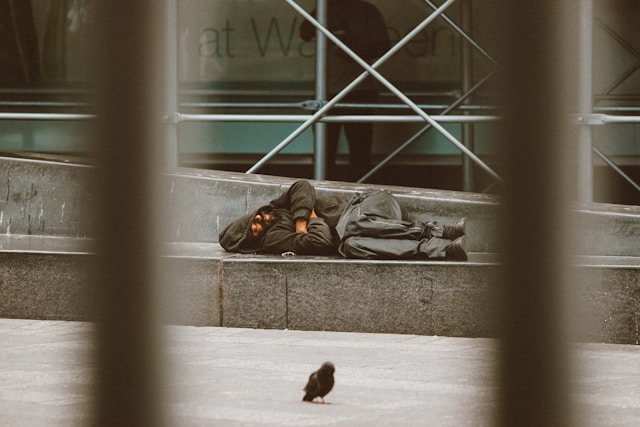
Some places force you to see what you’ve ignored.
Dubai made me confront contradictions I’d never reckoned with.
In San Diego, homelessness isn’t just a problem—it’s a daily onslaught: tents under bridges, makeshift encampments lining freeway overpasses, and garbage strewn across sidewalks. People sleep in their cars, at bus stops, on benches. A man shouts obscenities in the street, another strips naked and stumbles into an intersection.
The city feels like a crisis unfolding in slow motion—and it’s getting worse. Then I moved to Dubai, where suffering existed in subtler ways. Suffering doesn’t shout here. It’s structured, contained, often invisible—and yet it’s there.
Last year in San Diego, I stepped over a man sleeping in front of a café. More recently in Dubai, I sipped coffee in a gleaming mall while workers polished the floors in silence.
The contrast stayed with me: Which is worse—suffering you can’t ignore or suffering you never see?
Dubai presents a different reality. Walking through the city, I was struck by its order, immaculate streets, and the absence of people living in public spaces. At first, I thought the issue of poverty had been solved. But as I spent more time here, I realized that while there is no public destitution, economic hardship still exists—less visible but no less significant.
Instead of makeshift shelters on the streets, those struggling economically live in designated housing, commuting long distances for work. Their presence is woven into the city’s development—evident in early-morning buses carrying workers to job sites, and in the quiet resilience of those who send most of their earnings home to families they rarely see.
These workers don’t sleep under bridges; they sleep in crowded rooms, bound by strict curfews. They don’t beg on the streets; their wages are fixed by contracts that offer little choice. Their struggles don’t disrupt the public image of a flawless cityscape, but they are no less real.
If homelessness in the United States is a problem of abandonment—where people fall through the cracks with no safety net—then economic struggle in Dubai is a challenge of visibility. Hardship exists, but as part of an organized system that prevents extreme public destitution. This approach provides more structure and safeguards than the chaotic, often failing safety nets I’d grown used to in the U.S.
But what happens when suffering is unseen? In San Diego, homelessness is impossible to ignore. Whether we engage with it or not, it forces itself into our periphery—demanding pity, frustration, activism, or avoidance. We’re confronted daily with the question of whether we’ll acknowledge another person’s suffering.
Dubai operates differently. Hardship is tucked away, woven into the city’s daily rhythm. No tent encampments, no figures huddled in doorways, no handwritten signs asking for food.
If suffering is kept out of sight, does that make it any less real? If we don’t see it, do we still feel responsible for it?
Psychologists often refer to compassion fatigue—when overexposure to suffering makes us emotionally shut down. If that’s true, is Dubai’s lack of visible suffering a blessing or a blind spot? Do we need to see suffering to care? Or does invisibility make it easier to look away?
This isn’t just philosophical—it’s personal. As a conflict coach, mediator, and trainer, my work revolves around how we communicate and respond in moments of crisis. Visibility, or invisibility, of suffering shapes how we navigate conflict and social responsibility. Do we engage? Do we disconnect? More importantly—do we even notice?
I lived with homelessness as a constant, unavoidable presence in San Diego. I told myself that I cared—I donated, I did what I could. But deep down, I knew the truth: I had adapted. I had normalized it. I’d accepted that in one of the wealthiest cities in the world, this level of human suffering was just part of the backdrop.
I don’t have answers. But I do have questions: What if the man sleeping on the sidewalk wasn’t just a stranger, but your father, your son, your daughter—the person you love most in the world? Would he still be invisible—just another piece of the city’s landscape? What if the worker cleaning the sewers, washing the cars, or sweeping the mall floors was someone whose hand you had once held? Would you still walk by, unchanged? Would you still believe their struggle has nothing to do with you?
What if we stopped averting our eyes—what if we chose to see? Because the moment we acknowledge suffering, not as an abstract issue, but as part of our shared humanity, our perspective shifts. Sometimes, the hardest truth isn’t far away. It’s right in front of us, waiting for us to stop looking past it.
How to Acknowledge Suffering Instead of Looking Past It:
Notice. Next time you see someone sleeping on the street or quietly sweeping a mall floor, pause—truly see them.
Engage. If it feels right, offer a small gesture of kindness—a conversation, a meal, or a donation. Even a moment of human connection matters.
Reflect. Ask yourself how much you’ve normalized the suffering around you—visible or not. Each time you choose to see, you reaffirm our shared humanity.
~
 Share on bsky
Share on bsky
This account does not have permission to comment on Elephant Journal.
Contact support with questions.